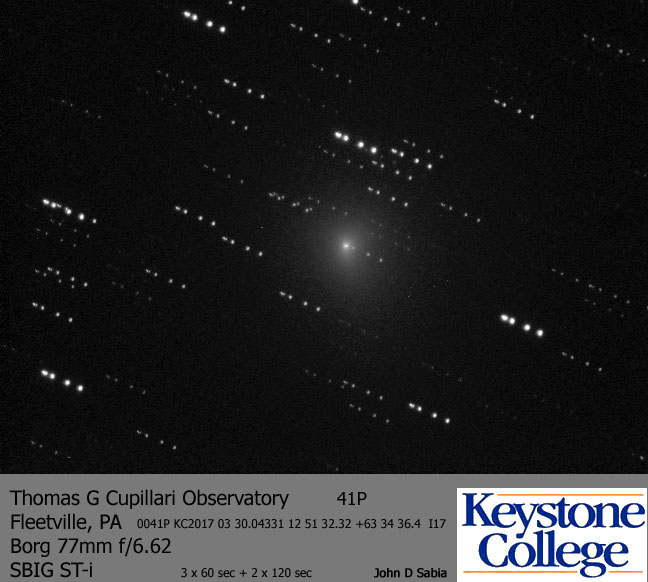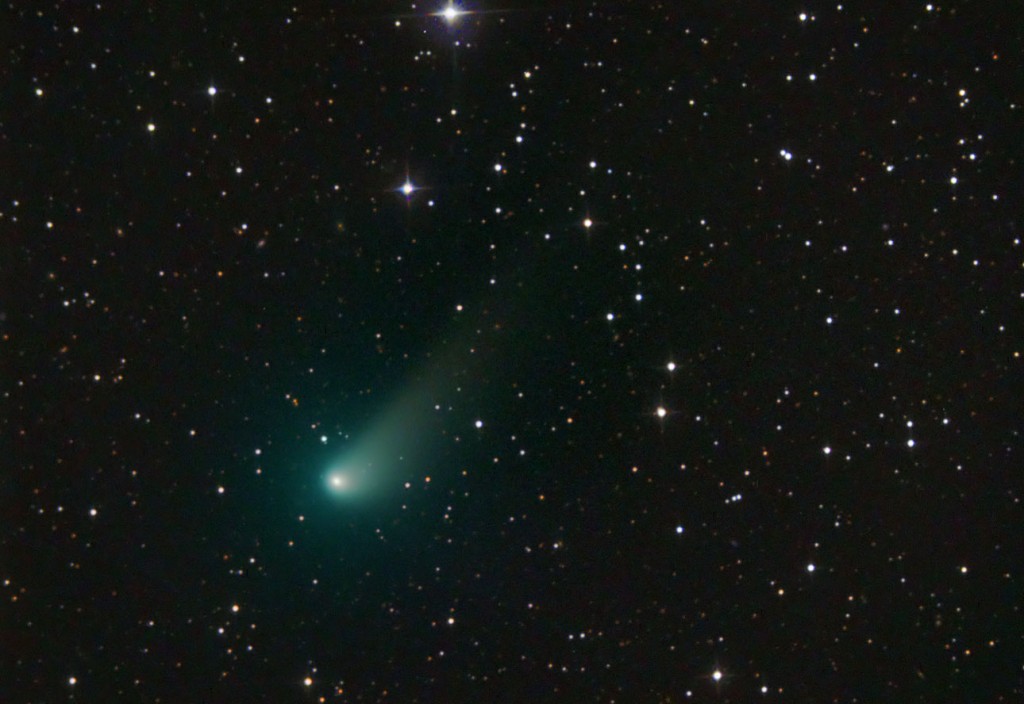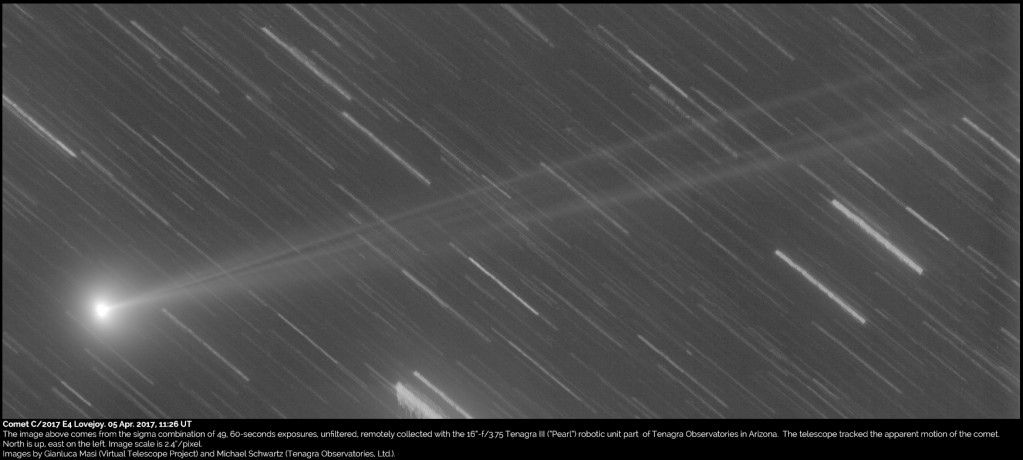ALPO COMET NEWS FOR APR 2017
2017-April-5
The sky is now full of bright comets. We expected periodic comet 41P/Tuttle-Giacobini-Kresak to be around 6th magnitude this month, but two others have also reached that level of brightness. C/2015 ER61 (PANSTARRS) experienced a 2 magnitude outburst on April 4 or 5 and is now 6th magnitude. Newly discovered C/2017 E4 (Lovejoy) was only first seen on March 12 and has rapidly brightened to magnitude 6.5. Considering C/2015 V2 (Johnson) is also still brightening, though it is “only” at 9th magnitude, there’s lots to see this month.
Last month the Comet Section received comet magnitude estimates for comets 2P/Encke, 41P/Tuttle-Giacobini-Kresak, C/2015 ER61 (PANSTARRS), C/2015 V2 (Johnson) and C/2017 E4 (Lovejoy) from Salvador Aguirre, Carl Hergenrother, John D. Sabia and Willian Souza. CCD images were also received for comets 41P/Tuttle-Giacobini-Kresak, 45P/Honda-Mrkos-Pajdusakova, 71P/Clark, 73P/Schwassmann-Wachmann 3, 315P/LONEOS, C/2015 ER61 (PANSTARRS), C/2015 V2 (Johnson) and C/2017 E4 (Lovejoy) from John Chumack, Carl Hergenrother, Gianluca Masi, John D. Sabia, Chris Schur and Michael Schwartz.
Morning Comets
2P/Encke [Perihelion on 2017 March 10 at 0.34 au]
Comet Encke brightened to 8th magnitude in late February before passing too close to the Sun to be seen. Willian Souza of Brazil was able to reobserve Encke on March 26 at magnitude 7.7. Encke will only be visible from the southern hemisphere as it moves through Aquarius. It will fade from 9th to 12th magnitude as it recedes from both the Sun (0.65 to 1.16 au) and Earth (0.91 to 1.16 au).
41P/Tuttle-Giacobini-Kresak [Perihelion on 2017 Apr 12 at 1.05 au]
41P/T-G-K approached to within 0.14 au of Earth on April 1. Though this comet has brightened to 6th magnitude and is well place for northern observers, it has proved a difficult object to see. As is common for intrinsically faint comets that come close to Earth, 41P is a large object with a low surface brightness coma. As a result, low magnification and dark skies are needed to see it. CCD imagers are having a better time recording this comet.
The comet should slowly fade from 6th to 7th magnitude this month. Though perihelion occurs on April 12 and its heliocentric distance doesn’t change much, its geocentric distance increases from 0.14 to 0.19 au. The comet is currently circumpolar in Draco at a declination of +64 deg. The comet will still be a northern object at the end of the month in Hercules (declination of +39 deg). While 41P is prone to enormous outbursts it has been well behaved so far.
Image below was taken by John D. Sabia on March 30 showing structure in the inner coma of 41P.
C/2015 ER61 (PANSTARRS) [Perihelion on 2017 May 9 at 1.04 au]
Up to a few days ago C/2015 ER61 (PANSTARRS) was slowly brightening and shining at magnitude 8.5. After a two magnitude outburst, the comet is now around magnitude 6.2 to 6.5. C/PANSTARRS will reach perihelion on May 9 at 1.04 au from the Sun but never gets closer to Earth than 1.18 au. For northern observers, it will be located low in the morning sky. It will be better placed for southern observers. This month its distance from the Sun increases from 1.22 au to 1.05 au. Its geocentric distance stays around 1.23 to 1.18 au as it travels through Capricornus (Apr 1-5), Aquarius (5-12), Capricornus (12-18), Aquarius (18-29) and Pisces (29-30). How bright it will be this month is uncertain. If its recent outburst is a short-lived event, the comet may fade back to 8th magnitude. Alternately, additional outbursts may further its brightening.
C/2015 V2 (Johnson) [Perihelion on 2017 June 12 at 1.64 au]
Comet Johnson is inbound with a perihelion of 1.64 au and close approach to Earth at 0.81 au this summer. It is well placed for northern observers through perihelion. Its rate of brightening has been slow so this month it is only expected to brighten from magnitude 9.5 to 8.5. During April, it is a morning object in Hercules at an elongation that increases from 108 to 118 degrees. It starts the month 1.90 au from the Sun and 1.33 au from Earth. At the end of the month, these values decrease to 1.73 au from the Sun and 1.01 au from Earth. C/Johnson is still on pace to peak between magnitude 7.5 and 8.0 this summer.
Image below was taken on April 2 by Chris Schur.
C/2017 E4 (Lovejoy) [Perihelion on 2017 April 23 at 0.49 au]
The latest Comet Lovejoy was discovered by Australian amateur Terry Lovejoy with a CCD-equipped 14″ SCT f/1.9 Hyperstar system. The first magnitude estimates placed it near magnitude 12 but the comet rapidly brightened and is now around magnitude 6.5. As April starts, C/Lovejoy is located 0.72 au from the Sun and 0.61 au from Earth. At perihelion on April 23, it will be 0.49 and 1.10 au from the Sun and Earth. The comet could brighten by an additional magnitude or two by then. Lovejoy will become more difficult to observe as the month progresses as its elongation from the Sun shrinks from 45 deg to 20 deg. The comet will remain a morning object all month as it moves through Pegasus (Apr 1-12), Andromeda (12-27) and Triangulum (27-30).
Image below was taken on April 5 by Gianluca Masi and Michael Schwartz.
As always, the Comet Section is happy to receive all comet observations, whether images, drawings or magnitude estimates.
- Carl Hergenrother (ALPO Comet Section Coordinator)






